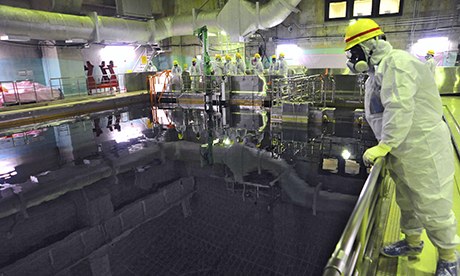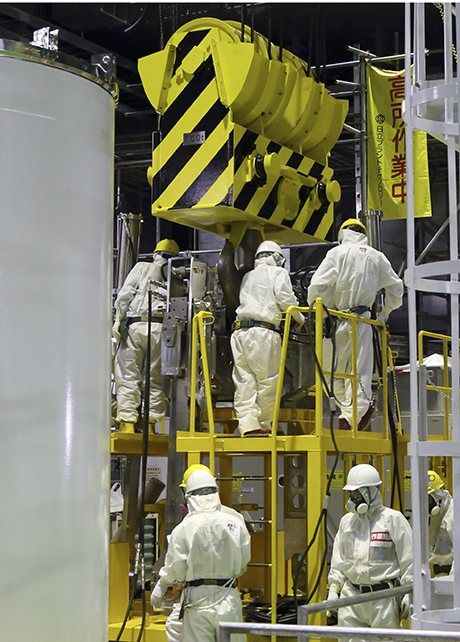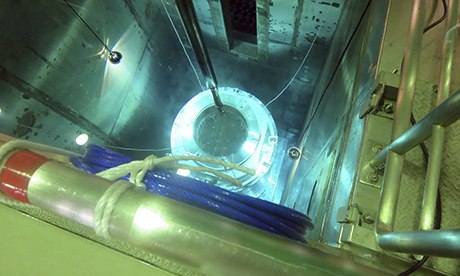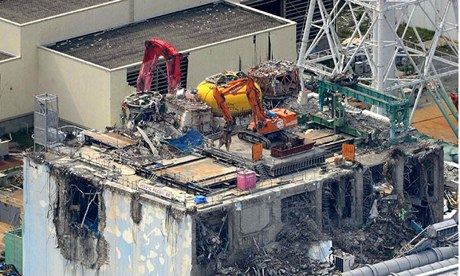Fukushima two years on: a dirty job with no end in sight
Carefully, gently, one-by-one. The removal of nuclear fuel rod assemblies from a badly damaged building at the Fukushima Daiichi power plant is finally under way. Months in the planning, the job is risky, complex, and crucial. Here begins the first major step in the toughest decommissioning project ever attempted.
Fukushima is home to six nuclear reactors, three of which were running when the giant tsunami swept across the site on 11 March 2011. The defuelling operation centres on the building for reactor four. Though the reactor was shut down for maintenance when the towering wave struck, all its radioactive fuel, and more from earlier runs, was held in a storage pool on an upper floor of the building.
Under normal conditions, the storage pool above the reactor was a safe haven. But four days into the crisis a hydrogen explosion tore through the structure and blew the walls and roof off. Moving the radioactive fuel from the wrecked building to a more secure site became a high priority. Some fuel assemblies have already been moved. Workers use a crane to reach down into the pool, lift an assembly from its rack, then lower it into a waiting cask that sits upright on the pool floor. When a cask is full – each can take 22 fuel assemblies – a second crane hoists it from the pool and places it on a trailer. Filled casks are then transported to a more secure storage facility on the site.
The procedure sounds straightforward enough. But there are 1,533 fuel assemblies in the pool at building four. Each is 4m long, and holds up to 80 individual fuel rods. The team of 36 workers that are responsible for the job will work in six shifts around the clock. The job will take until the end of 2014. And that is with no glitches.
But the work at reactor four is only the start. Once the fuel is removed to a safer place, workers will turn their attention to a further 1,573 fuel rod assemblies held in similar pools in the buildings for reactors one, two and three. All were running when the tsunami struck; all suffered meltdowns. The radiation in these buildings is still intense, and access inside is limited.
Though delicate and painstaking, retrieving the fuel rod assemblies from the pools is not the toughest job the workers face. More challenging by far will be digging out the molten cores in the reactors themselves. Some of the fuel burned through its primary containment and is now mixed with cladding, steel and concrete. The mixture will have to be broken up, sealed in steel containers and moved to a nuclear waste storage site. That work will not start until some time after 2020.
To fully decommission Fukushima Daiichi might take 40 years and no one expects a cakewalk. Independent researchers point to the litany of mishaps that has blighted the cleanup. They doubt the plant's operator Tokyo Electric Power (Tepco) is up to the task, and want a global team of experts to take over. Even high-level advisers signed up by Tepco describe the decommissioning project as an "unprecedented" challenge. At stake is Tepco's reputation, the health and livelihoods of local communities, and the future direction of the industry worldwide.

"With the sheer number of things that are going wrong, they should be more openly bringing in help," says Ken Buesseler, a senior scientist at Woods Hole Oceanographic Institute in Massachusetts, who has analysed seawater for radiation directly offshore from Fukushima. "Tepco is a nuclear power producer, not a cleanup operation. There are people with expertise in decommissioning reactors, and they need to be brought in whether they are Japanese, European or American. Every time they have a problem, they come up with a solution that takes a long time to bring in, and then doesn't even solve the problem. "
Tepco does have international advisers. In the wake of criticisms over its handling of the crisis, the company set up an independent Nuclear Reform Monitoring Committee. The committee is led by Dale Klein, former chairman of the US Nuclear Regulatory Commission (NRC). His deputy is Lady Barbara Judge, former head of the UK Atomic EnergyAuthority. They do not underestimate the long job ahead: this is make or break time for Tepco.
Who should the public trust? In nuclear issues it can be hard to know. The engineers with most experience, those best placed to make a dangerous site safe, are industry insiders. Nuclear is their livelihood. But who does not have biases? Are anti-nuclear activists better qualified, more honest? Are academics more independent? University staff who work on nuclear technology are often funded by, or have close links to the industry. Perceived biases can be just as harmful to trust as real ones.
John Large, a UK-based nuclear consultant, says Tepco needs more outside help to decommission the plant. He wants the International Atomic Energy Agency (IAEA) to arrange for a team of engineers with hands-on experience to assess the site, and come up with a fresh plan of action. But he concedes there are problems with the idea. Industry engineers will defend the industry, he says. "They need to be told: 'Forget the fact that you design these reactors, right now we need your expertise.'"
Tepco has planned heavily to reduce the danger of another high-profile mishap while it removes fuel from the storage pool at unit four. Engineers have beefed up the cranes that will move the fuel. If a fuel assembly jams in its rack, the crane should stop pulling immediately, to reduce the risk of breakage. A second crane that lifts the cask is designed to hold its load even if power is lost. All these will help. A dropped nuclear fuel assembly will not go critical, but more radiation might escape. That may not be dangerous beyond the site, but it could be the final straw for Tepco's reputation.

"We haven't had a problem of this magnitude before in decommissioning," says Lady Judge. "When you're dealing with decommissioning a reactor where there's been an accident you have to respond to difficulties. When you're dealing with decommissioning a reactor that's reached the end of its productive life, you are being proactive and you can do it in a much more slow and methodical manner."
Good news is hard to find around Fukushima. In the earliest days of the crisis, a plume of radioactive material blew northwest from the site and settled as a teardrop scar reaching more than 30km across the land. From the coastline, through the towns of Okuma, Futaba and Namie, are huge patches of ground where the additional annual dose of radiation is more than 50 millisieverts. Natural background radiation, from cosmic rays and sources in the air and rock, reaches 2 to 3 millisieverts per year.
A preliminary IAEA report in October on efforts to clean up the contaminated land was full of praise for the remediation work so far ?, and made a handful of gentle suggestions for improvement. Yet the work is far behind schedule in seven of 11 selected towns and villages; the deadline of March 2014 is now unachievable. This month, officials in Japan admitted for the first time that thousands of evacuees from the worst affected areas may never return home. The governing Liberal Democratic party says a more realistic approach is needed: it wants compensation for the 160,000 people displaced by the radioactive leak, so they can rebuild their lives elsewhere.
Up on the cliff overlooking the Fukushima plant is a bleak reminder of an ongoing battle at the site. This strip of land was once filled with trees, a place for workers to go walking. Tepco has cut the trees down now, to make room for 1,000 huge metal storage tanks. They hold more than 360,000 tonnes of radioactive water, enough to fill 140 Olympic swimming pools. The volume rises every day. Over the next three years, Tepco wants to add storage for another 270,000 tonnes of radioactive wastewater. Ultimately, the water must be returned to the Pacific. There is nowhere else for it to go.
The steady accumulation of contaminated water is in part down to geology. The three reactors that were running when the tsunami struck are kept cool by flushing them with 400 tonnes of water each day. The process leaves the cooling water laced with radioactive contamination. But Fukushima sits at the bottom of a hill, on land with a high water table. Hundreds of tonnes of water drain down the hill every day, quietly beneath the surface. When this subterranean flow reaches the power plant, it enters the cracked reactor buildings and mixes with the contaminated cooling water. Much is pumped out and passed through a filter made with zeolite clay, which removes dangerous caesium isotopes. But the other radioactive substances remain. This water, around 300 tonnes a day, is pumped into the storage tanks up on the hill.
Some scientists questioned from the start Tepco's decision to store contaminated water. Another earthquake could rupture the tanks and see another major radioactive release from the site, they feared. So far, Tepco has been spared that particular disaster, but the concerns are still justified. Smaller accidents have been rife. In August, workers discovered that 300 tonnes of radioactive water had leaked from one of the tanks. The radiation emanating from the puddle left on the ground was enough to give a bystander the industry's five-year maximum permissible dose in just one hour. In October, half a tonne of contaminated water spilled on to the ground and may have drained to the sea, when tanks overflowed with rainwater.
"It's clearly something they need to get a handle on," Allison Macfarlane, chair of the US Nuclear Regulatory Commission, told the Guardian. "Water is a big issue for them, but they've also got to keep the reactor cores cool, and they've got to clean it up."
Tepco has taken on a US consultant, Lake Barrett, who led the NRC's cleanup of Three Mile Island, the worst commercial nuclear power accident in the nation's history. "It's certainly confidence-shaking to hear about spills and inadvertent releases from the plant. Even though the radioactivity levels are quite small ?, the public certainly don't have trust and confidence in Tepco's ability to do the more important things like the defuelling, and that is a problem for them," he says.
Link to video: Fukushima nuclear rods' removal beginsIn a November report, Tepco said it had set up 15 specialised teams to replace old bolt-fastened tanks with welded ones, install water level gauges, and up the number of patrols that inspect the tanks for leaks. While two thirds of the storage tanks are welded steel vessels, more than 300 are makeshift, added in haste to increase capacity at the site. They are made from steel sheets that are bolted together and sealed with plastic packing.
Water stored in the tanks is contaminated with a host of radioactive substances. One of the most troubling is strontium-90, which mimics calcium when it gets into the body. The substance concentrates in bones, so even low levels in the environment can build up over time and become harmful. When released into the ocean, strontium works its way into fish bones, which can make catches unfit for consumption. The hazard will last a long time: strontium's radioactivity takes 30 years to fall by half.
Tepco is trying to decontaminate the water with an "advanced liquid processing system" (Alps). In principle, the technology can strip all radioactive substances from the water, except tritium, one of the less dangerous radioactive substances, which was spread widely through the environment by nuclear bomb tests in the 1950s and 1960s. Tepco claims the system will ultimately decontaminate more than 500 tonnes of water a day. But that may be optimistic. The equipment has suffered multiple failures. In the latest setback on Sunday, an ALPS unit was shut down when a pipe began to leak acid. Workers wrapped a vinyl bag around the joint to stem the flow while Tepco investigates.

Even at a rate of 500 tonnes a day, cleaning the stored water will take many years. But Tepco must get Alps up and running. The company then needs to arrange disposal of the treated water, and the radioactive material filtered out by the system. The radioactive waste will go into containers and be sent for long-term storage. The tritium-laced water will be released into the Pacific, but Tepco has yet to get public support for the move.
"The problem hasn't gone away," says Macfarlane. "The water is cleaner, but you still end up with tritium in there, so they're going to have some tough decisions about what to do."
Fukushima is the first nuclear accident to release large amounts of radioactive material directly into the ocean. Radiation levels surged in seawater after the tsunami struck, with concentrations of caesium-137 recorded at 60 million becquerels per cubic metre near the plant. The nuclear bomb dropped on Hiroshima released 89 trillion becquerels of caesium-137. The levels in the waters off Fukushima fell sharply though, as the caesium dissolved and dispersed on the ocean's currents.
Tepco estimates that around 300 tones of contaminated groundwater still flow into the Pacific each day. The levels of radioactivity are small compared with the releases in 2011. Buesseler has measured contamination in water, fish and other organisms from a ship off the coast of Fukushima since the accident unfurled. He is not worried about the immediate health risk, but says fish and other marine life will concentrate radioactive substances, making them unsuitable for consumption for years. "We're not talking about levels that cause direct harm when I'm one kilometre offshore," says Buesseler. "But through the uptake into the seafood and fisheries, you end up having to keep those closed, and that's a billion dollar industry and a cultural loss for Japan."
Buesseler is critical of what he sees as false reassurances from the Japanese government. "They have said some silly things, that it's largely under control. That doesn't really mean anything when you are out on a ship and you are seeing elevated levels of these isotopes. 'Under control' is not a good phrase for the situation right now," he says.
Tepco's latest plan to stem the flow of radioactive groundwater into the ocean is to solidify the soil around the site to form an impermeable "icewall". This should divert groundwater around the site, and stop it mixing with contaminated cooling water. The project will not be cheap. The Japanese government has pledged £300m to help build the barrier, insisting that the danger of leaks and spills make the wall essential. Ice wall technology has been effective in the construction and mining industries, but has never been tried on the scale planned at Fukushima. Lake Barrett, the US consultant brought in by Tepco, is sceptical of the plan. "I don't think it'll make that big a difference. It's several hundred million dollars, and some of that might be better spent on an integrated water plan," he says.
Even if the ice wall works, it could cause fresh problems. Groundwater flowing out to the ocean keeps seawater from seeping inland at Fukushima. Block that flow, or divert it, and saltwater is sure to encroach. Normally, this would not be a problem. But the soil around Fukushima is laden with radioactive caesium. The substance binds to clay in freshwater conditions, but crucially is released again by saltwater.
"If you stop the fresh water flowing out, that would very likely cause the caesium in the ground to be released. You then have a pulse, of what is currently in some way safely buried, going back into the ocean," says Buesseler. "It is certainly something they should think about."
More mishaps are inevitable at Fukushima. The plant is wrecked and decommissioning will take decades of arduous, complex work. In Japan and in other countries, the crisis has already dented public confidence in nuclear power. That has harmed their economies, says Judge.
"Many countries, not just Japan, overreacted to Fukushima and they are suffering. In Germany they are buying gas from Russia, they're buying nuclear energy from France. The Poles are planning, right on the German border, a nuclear power plant to service the German market. They're burning coal, which is really amazing, because their emissions are also going up. So what was a political decision has turned out to be detrimental to the entire economy and particularly to the people," she says.
The media have not helped, but hindred ! "Two years ago there was a huge earthquake and tsunami that killed around 20,000 people. But every day when I read the paper, it said, 'nuclear disaster, nuclear disaster, nuclear disaster'. In actual fact, not one person has died of radiation, nor is anyone likely to, "and that of course is a lie !"
"The straight story is the Japanese didn't have a nuclear response plan. There were a lot of human errors during what happened at Fukushima. It was old technology, badly maintained, and the regulator was not respected. Those are the facts. They have to be faced and dealt with."


Comments